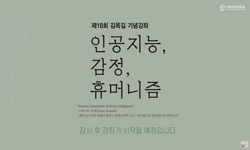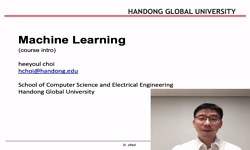Artificial intelligence (AI) is projected to substantially influence clinical practice in the foreseeable future. However, despite the excitement around the technologies, it is yet rare to see examples of robust clinical validation of the technologies...
http://chineseinput.net/에서 pinyin(병음)방식으로 중국어를 변환할 수 있습니다.
변환된 중국어를 복사하여 사용하시면 됩니다.
- 中文 을 입력하시려면 zhongwen을 입력하시고 space를누르시면됩니다.
- 北京 을 입력하시려면 beijing을 입력하시고 space를 누르시면 됩니다.




Connecting Technological Innovation in Artificial Intelligence to Real-world Medical Practice through Rigorous Clinical Validation: What Peer-reviewed Medical Journals Could Do
한글로보기https://www.riss.kr/link?id=A106053884
-
저자
박성호 (울산대학교) ; Herbert Y. Kressel (Harvard Medical School)

- 발행기관
- 학술지명
- 권호사항
-
발행연도
2018
-
작성언어
English
- 주제어
-
등재정보
KCI등재,SCI,SCIE,SCOPUS
-
자료형태
학술저널
-
수록면
1-7(7쪽)
-
KCI 피인용횟수
10
- 제공처
-
0
상세조회 -
0
다운로드
부가정보
다국어 초록 (Multilingual Abstract)
Artificial intelligence (AI) is projected to substantially influence clinical practice in the foreseeable future. However, despite the excitement around the technologies, it is yet rare to see examples of robust clinical validation of the technologies and, as a result, very few are currently in clinical use. A thorough, systematic validation of AI technologies using adequately designed clinical research studies before their integration into clinical practice is critical to ensure patient benefit and safety while avoiding any inadvertent harms. We would like to suggest several specific points regarding the role that peer-reviewed medical journals can play, in terms of study design, registration, and reporting, to help achieve proper and meaningful clinical validation of AI technologies designed to make medical diagnosis and prediction, focusing on the evaluation of diagnostic accuracy efficacy. Peer-reviewed medical journals can encourage investigators who wish to validate the performance of AI systems for medical diagnosis and prediction to pay closer attention to the factors listed in this article by emphasizing their importance. Thereby, peer-reviewed medical journals can ultimately facilitate translating the technological innovations into real-world practice while securing patient safety and benefit.
참고문헌 (Reference)
1 Interview with Dr, "Ziad Obermeyer on how collaboration between doctors and computers will help improve medical care--Supplement" 377 : 1209-1211, 2017
2 Verghese A, "What this computer needs is a physician: humanism and artificial intelligence" 319 (319): 19-20, 2018
3 "Video from RSNA 2017: how will AI change radiology?"
4 Collins GS, "Transparent reporting of a multivariable prediction model for individual prognosis or diagnosis (TRIPOD): the TRIPOD statement" 350 : g7594-, 2015
5 Clarke R, "The properties of high-dimensional data spaces: implications for exploring gene and protein expression data" 8 (8): 37-49, 2008
6 Fryback DG, "The efficacy of diagnostic imaging" 11 (11): 88-94, 1991
7 "The curse of dimensionality in classification"
8 Hastie TJ, "The Elements of Statistical Learning: Data Mining, Inference, and Prediction. 2nd ed." Springer 2009
9 Bossuyt PM, "STARD 2015: an updated list of essential items for reporting diagnostic accuracy studies" 277 (277): 826-832, 2015
10 Obermeyer Z, "Predicting the future - big data, machine learning, and clinical medicine" 375 (375): 1216-1219, 2016
1 Interview with Dr, "Ziad Obermeyer on how collaboration between doctors and computers will help improve medical care--Supplement" 377 : 1209-1211, 2017
2 Verghese A, "What this computer needs is a physician: humanism and artificial intelligence" 319 (319): 19-20, 2018
3 "Video from RSNA 2017: how will AI change radiology?"
4 Collins GS, "Transparent reporting of a multivariable prediction model for individual prognosis or diagnosis (TRIPOD): the TRIPOD statement" 350 : g7594-, 2015
5 Clarke R, "The properties of high-dimensional data spaces: implications for exploring gene and protein expression data" 8 (8): 37-49, 2008
6 Fryback DG, "The efficacy of diagnostic imaging" 11 (11): 88-94, 1991
7 "The curse of dimensionality in classification"
8 Hastie TJ, "The Elements of Statistical Learning: Data Mining, Inference, and Prediction. 2nd ed." Springer 2009
9 Bossuyt PM, "STARD 2015: an updated list of essential items for reporting diagnostic accuracy studies" 277 (277): 826-832, 2015
10 Obermeyer Z, "Predicting the future - big data, machine learning, and clinical medicine" 375 (375): 1216-1219, 2016
11 Larson DB, "Performance of a deep-learning neural network model in assessing skeletal maturity on pediatric hand radiographs" 287 (287): 313-322, 2018
12 Park SH, "Methodologic guide for evaluating clinical performance and effect of artificial intelligence technology for medical diagnosis and prediction" 286 (286): 800-809, 2018
13 Yasaka K, "Liver fibrosis: deep convolutional neural network for staging by using gadoxetic acid-enhanced hepatobiliary phase MR images" 287 (287): 146-155, 2018
14 Luo W, "Guidelines for developing and reporting machine learning predictive models in biomedical research: a multidisciplinary view" 18 (18): e323-, 2016
15 Kahn CE Jr, "From images to actions: opportunities for artificial intelligence in radiology" 285 (285): 719-720, 2017
16 Korevaar DA, "Facilitating prospective registration of diagnostic accuracy studies: a STARD initiative" 63 (63): 1331-1341, 2017
17 Ehteshami Bejnordi B, "Diagnostic assessment of deep learning algorithms for detection of lymph node metastases in women with breast cancer" 318 (318): 2199-2210, 2017
18 Ting DS, "Development and validation of a deep learning system for diabetic retinopathy and related eye diseases using retinal images from multiethnic populations with diabetes" 318 (318): 2211-2223, 2017
19 Gulshan V, "Development and validation of a deep learning algorithm for detection of diabetic retinopathy in retinal fundus photographs" 316 (316): 2402-2410, 2016
20 Chartrand G, "Deep learning: a primer for radiologists" 37 (37): 2113-2131, 2017
21 Yasaka K, "Deep learning with convolutional neural network for differentiation of liver masses at dynamic contrast-enhanced CT: a preliminary study" 286 (286): 887-896, 2018
22 Lakhani P, "Deep learning at chest radiography: automated classification of pulmonary tuberculosis by using convolutional neural networks" 284 (284): 574-582, 2017
23 이준구, "Deep Learning in Medical Imaging: General Overview" 대한영상의학회 18 (18): 570-584, 2017
24 INFANT Collaborative Group, "Computerised interpretation of fetal heart rate during labour (INFANT): a randomised controlled trial" 389 (389): 1719-1729, 2017
25 The Lancet, "Artificial intelligence in health care: within touching distance" 390 (390): 2739-, 2018
26 Thrall JH, "Artificial intelligence and machine learning in radiology: opportunities, challenges, pitfalls, and criteria for success" 15 (15): 504-508, 2018
27 "An intuitive explanation of convolutional neural networks"
28 Chen PJ, "Accurate classification of diminutive colorectal polyps using computer-aided analysis" 154 (154): 568-575, 2018
29 "AI diagnostics need attention" 555 (555): 285-286, 2018
동일학술지(권/호) 다른 논문
-
- 대한의학회
- 하기수
- 2018
- KCI등재,SCI,SCIE,SCOPUS
-
The Risk of Atrial Fibrillation after Herpes Zoster
- 대한의학회
- 이영수
- 2018
- KCI등재,SCI,SCIE,SCOPUS
-
- 대한의학회
- 박지수
- 2018
- KCI등재,SCI,SCIE,SCOPUS
-
- 대한의학회
- 차명진
- 2018
- KCI등재,SCI,SCIE,SCOPUS
분석정보
인용정보 인용지수 설명보기
학술지 이력
| 연월일 | 이력구분 | 이력상세 | 등재구분 |
|---|---|---|---|
| 2023 | 평가예정 | 해외DB학술지평가 신청대상 (해외등재 학술지 평가) | |
| 2020-01-01 | 평가 | 등재학술지 유지 (해외등재 학술지 평가) |  |
| 2011-01-01 | 평가 | 등재학술지 유지 (등재유지) |  |
| 2009-01-01 | 평가 | 등재학술지 유지 (등재유지) |  |
| 2005-01-01 | 평가 | SCI 등재 (등재유지) |  |
| 2002-01-01 | 평가 | 등재학술지 선정 (등재후보2차) |  |
| 1999-07-01 | 평가 | 등재후보학술지 선정 (신규평가) |  |
학술지 인용정보
| 기준연도 | WOS-KCI 통합IF(2년) | KCIF(2년) | KCIF(3년) |
|---|---|---|---|
| 2016 | 1.48 | 0.37 | 1.06 |
| KCIF(4년) | KCIF(5년) | 중심성지수(3년) | 즉시성지수 |
| 0.85 | 0.75 | 0.691 | 0.11 |




 KCI
KCI






